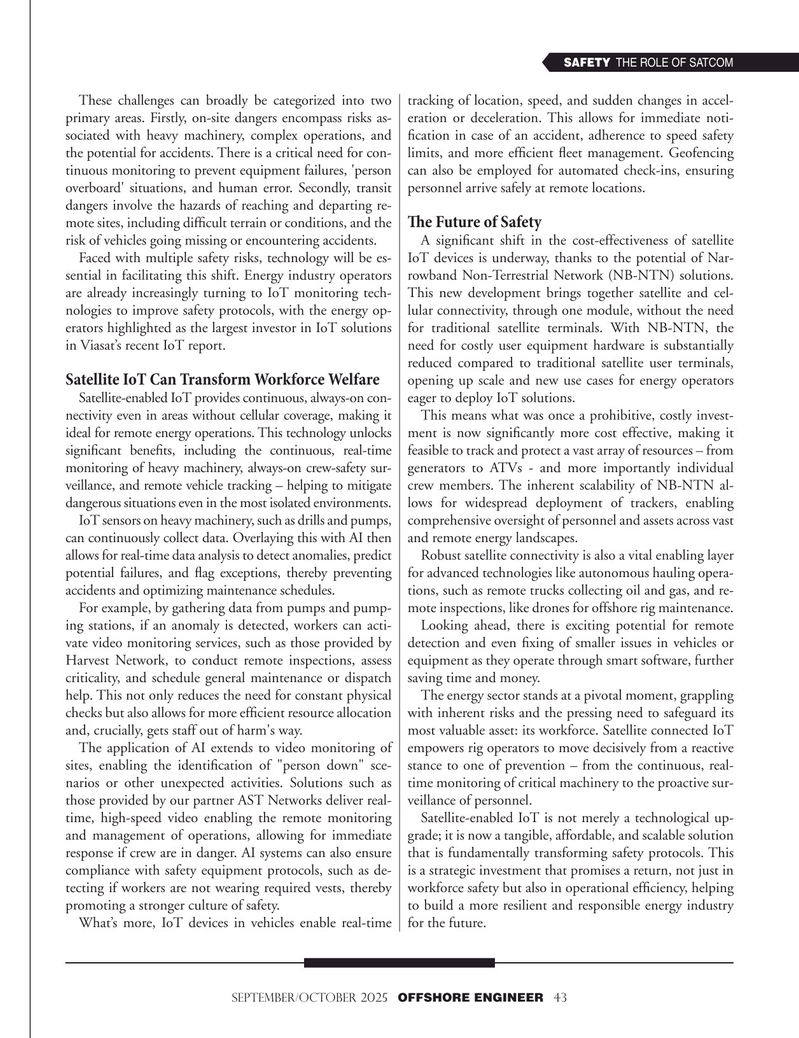
Page 43: of Offshore Engineer Magazine (Sep/Oct 2025)
Read this page in Pdf, Flash or Html5 edition of Sep/Oct 2025 Offshore Engineer Magazine
SAFETY THE ROLE OF SATCOM
These challenges can broadly be categorized into two tracking of location, speed, and sudden changes in accel- primary areas. Firstly, on-site dangers encompass risks as- eration or deceleration. This allows for immediate noti- sociated with heavy machinery, complex operations, and fcation in case of an accident, adherence to speed safety the potential for accidents. There is a critical need for con- limits, and more effcient feet management. Geofencing tinuous monitoring to prevent equipment failures, 'person can also be employed for automated check-ins, ensuring overboard' situations, and human error. Secondly, transit personnel arrive safely at remote locations.
dangers involve the hazards of reaching and departing re-
Te Future of Safety mote sites, including diffcult terrain or conditions, and the risk of vehicles going missing or encountering accidents. A signifcant shift in the cost-effectiveness of satellite
Faced with multiple safety risks, technology will be es- IoT devices is underway, thanks to the potential of Nar- sential in facilitating this shift. Energy industry operators rowband Non-Terrestrial Network (NB-NTN) solutions. are already increasingly turning to IoT monitoring tech- This new development brings together satellite and cel- nologies to improve safety protocols, with the energy op- lular connectivity, through one module, without the need erators highlighted as the largest investor in IoT solutions for traditional satellite terminals. With NB-NTN, the in Viasat’s recent IoT report. need for costly user equipment hardware is substantially reduced compared to traditional satellite user terminals, opening up scale and new use cases for energy operators
Satellite IoT Can Transform Workforce Welfare
Satellite-enabled IoT provides continuous, always-on con- eager to deploy IoT solutions. nectivity even in areas without cellular coverage, making it This means what was once a prohibitive, costly invest- ideal for remote energy operations. This technology unlocks ment is now signifcantly more cost effective, making it signifcant benefts, including the continuous, real-time feasible to track and protect a vast array of resources – from monitoring of heavy machinery, always-on crew-safety sur- generators to ATVs - and more importantly individual veillance, and remote vehicle tracking – helping to mitigate crew members. The inherent scalability of NB-NTN al- dangerous situations even in the most isolated environments. lows for widespread deployment of trackers, enabling
IoT sensors on heavy machinery, such as drills and pumps, comprehensive oversight of personnel and assets across vast can continuously collect data. Overlaying this with AI then and remote energy landscapes.
allows for real-time data analysis to detect anomalies, predict Robust satellite connectivity is also a vital enabling layer potential failures, and fag exceptions, thereby preventing for advanced technologies like autonomous hauling opera- accidents and optimizing maintenance schedules. tions, such as remote trucks collecting oil and gas, and re-
For example, by gathering data from pumps and pump- mote inspections, like drones for offshore rig maintenance. ing stations, if an anomaly is detected, workers can acti- Looking ahead, there is exciting potential for remote vate video monitoring services, such as those provided by detection and even fxing of smaller issues in vehicles or
Harvest Network, to conduct remote inspections, assess equipment as they operate through smart software, further criticality, and schedule general maintenance or dispatch saving time and money.
help. This not only reduces the need for constant physical The energy sector stands at a pivotal moment, grappling checks but also allows for more effcient resource allocation with inherent risks and the pressing need to safeguard its and, crucially, gets staff out of harm's way. most valuable asset: its workforce. Satellite connected IoT
The application of AI extends to video monitoring of empowers rig operators to move decisively from a reactive sites, enabling the identifcation of "person down" sce- stance to one of prevention – from the continuous, real- narios or other unexpected activities. Solutions such as time monitoring of critical machinery to the proactive sur- those provided by our partner AST Networks deliver real- veillance of personnel. time, high-speed video enabling the remote monitoring Satellite-enabled IoT is not merely a technological up- and management of operations, allowing for immediate grade; it is now a tangible, affordable, and scalable solution response if crew are in danger. AI systems can also ensure that is fundamentally transforming safety protocols. This compliance with safety equipment protocols, such as de- is a strategic investment that promises a return, not just in tecting if workers are not wearing required vests, thereby workforce safety but also in operational effciency, helping promoting a stronger culture of safety. to build a more resilient and responsible energy industry
What’s mor e, IoT devices in vehicles enable real-time for the future.
SEPTEMBER/OCTOBER 2025 OFFSHORE ENGINEER 43

 42
42

 44
44